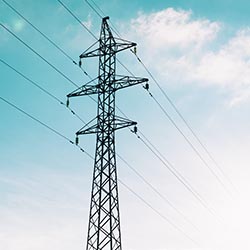Learn About Electricity
Scientifically, electricity is the flow of electrons from one atom to another, creating a charged current. One of the most widely used forms of energy, electricity is used in the application of heat, light and power.

Where Does Electricity Come From?
Electricity occurs naturally, for example, though lightning, but is most commonly generated using both renewable and non-renewable sources of energy. Renewable, or “green,” energy refers to electricity which is generated using natural resources that continually replenish, for example, wind, solar and water. Non-renewable, or “brown” energy refers to electricity which is generated using resources that do not renew at a sustainably sufficient rate, for example coal, natural gas, and uranium. Generation or power plants are used to convert those energy sources to electricity.
How is it Transported?
The electricity produced by a generator travels along cables to a transformer that changes it from low voltage to high voltage, allowing it to travel long distances more efficiently. Transmission lines are then used to carry the electricity to substations, where additional transformers change it from high voltage into lower voltage electricity. From the substation, distribution lines carry the electricity to homes and businesses. Because electricity cannot be stored, it is used as it is generated.
How is it Measured?
Electricity is measured in units of power called watts. A kilowatt represents 1,000 watts. A kilowatt-hour (kWh) is equal to the energy of 1,000 watts working for 1 hour. Kilowatt-hours are determined by multiplying the number of kilowatts required, by the number of hours of use.
For example, a customer who uses a 40-watt light bulb for 5 hours a day has used 200 watts of power, or .2 kilowatt-hours of electrical energy.
As electricity enters a customer’s home or business, it passes through a meter. The meter, which is usually connected to a wall of the customer’s home or business, tracks the customer’s electricity usage. The utility company obtains the customer’s usage, and bills the customer accordingly at a specified rate per kWh.
How is it Priced?
Generators sell electricity to purchasers (i.e., utility companies and independent suppliers) through regional, non-profit clearinghouses called Independent System Operators (ISOs). Pricing for electricity is impacted by supply and demand. An increase in supply tends to pull prices down, while a decrease in supply tends to push prices up.
Because electricity generation is dependent upon the energy sources used to generate it, the factors that impact those primary sources for electricity supply also impact the price of electricity for example:
- Severe weather
- Variations in production
- Net imports
- Storage levels
Higher demand tends to lead to higher prices, while lower demand tends to lead to lower prices. Factors that impact demand are:
- Economic growth
- Winter and summer weather
- Oil prices
There is a different price for electricity every 15 minutes of every day of the year, with the highest prices occurring during the hottest time of day during the hottest time of the year. Our Supply team makes every effort to purchase electricity when prices are low, which facilitates the company’s ability to offer competitive prices to its customers.










